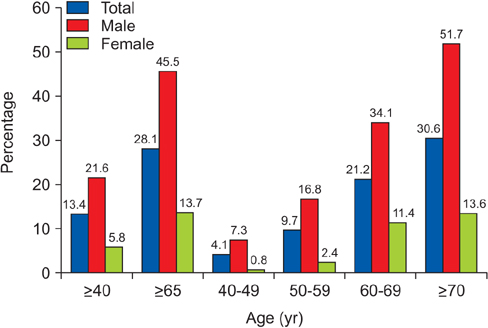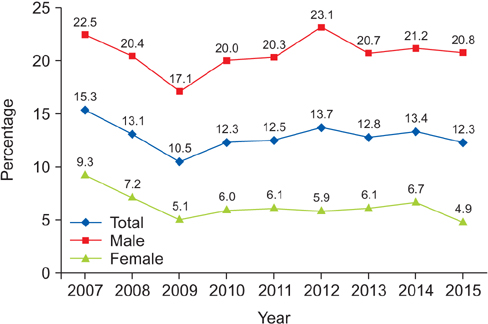Recent Trends in the Prevalence of Chronic Obstructive Pulmonary Disease in Korea
- Affiliations
-
- 1Division of Pulmonary, Allergy and Critical Care Medicine, Department of Internal Medicine, Hallym University Sacred Heart Hospital, Anyang, Korea. hyicyk@hallym.or.kr
- 2Lung Research Institute of Hallym University College of Medicine, Chuncheon, Korea.
- 3Division of Pulmonary, Allergy and Critical Care Medicine, Department of Internal Medicine, Hallym University Kangdong Sacred Heart Hospital, Seoul, Korea.
- 4Department of Internal Medicine, Konkuk University School of Medicine, Seoul, Korea.
- KMID: 2385036
- DOI: http://doi.org/10.4046/trd.2017.80.3.226
Abstract
- Chronic obstructive pulmonary disease (COPD) had been considered the only major disease that is continuing to increase in prevalence. There were a few studies about the change of the prevalence of COPD, which showed the prevalence of COPD did not increase. In this review, we report on the trends in the prevalence of COPD in Korea using the data from Korea National Health and Nutrition Examination Survey (KNHANES). The prevalence of COPD in 2015 was 13.4% (male, 21.6%; female, 5.8%). The prevalence of COPD did not change much, which ranged from 13.1% to 14.6% during the period from 2010 to 2015. Among the subjects found to have COPD by spirometry, only 2.8% had been diagnosed as COPD by physicians during the period from 2011 and 2015. In conclusion, the prevalence of COPD did not change significantly during the period from 2010 to 2015. And most COPD patients still had not been diagnosed by physicians and consequently had not been treated appropriately.
Keyword
MeSH Terms
Figure
Cited by 8 articles
-
Current Situation of Home Oxygen Therapy for Chronic Obstructive Pulmonary Disease Patients in Korea
Joo Kyung Kim, Seung Hun Jang, Sunghoon Park, Joo-Hee Kim, Ji-Young Park, Kwang Ha Yoo, Young Sam Kim, Seong Yong Lim, Yong Il Hwang
J Korean Med Sci. 2020;35(4):. doi: 10.3346/jkms.2020.35.e12.Revised (2018) COPD Clinical Practice Guideline of the Korean Academy of Tuberculosis and Respiratory Disease: A Summary
Yong-Bum Park, Chin Kook Rhee, Hyoung Kyu Yoon, Yeon-Mok Oh, Seong Yong Lim, Jin Hwa Lee, Kwang-Ha Yoo, Joong Hyun Ahn,
Tuberc Respir Dis. 2018;81(4):261-273. doi: 10.4046/trd.2018.0029.Prevalence and socioeconomic burden of chronic obstructive pulmonary disease
Tai Joon An, Hyoung Kyu Yoon
J Korean Med Assoc. 2018;61(9):533-538. doi: 10.5124/jkma.2018.61.9.533.Development of Prediction Equation of Diffusing Capacity of Lung for Koreans
Yong Il Hwang, Yong Bum Park, Hyoung Kyu Yoon, Seong Yong Lim, Tae-Hyung Kim, Joo Hun Park, Won-Yeon Lee, Seong Ju Park, Sei Won Lee, Woo Jin Kim, Ki Uk Kim, Kyeong Cheol Shin, Do Jin Kim, Hui Jung Kim, Tae-Eun Kim, Kwang Ha Yoo, Jae Jeong Shim
Tuberc Respir Dis. 2018;81(1):42-48. doi: 10.4046/trd.2017.0118.Correlation between Physical Activity and Lung Function in Dusty Areas: Results from the Chronic Obstructive Pulmonary Disease in Dusty Areas (CODA) Cohort
Yuri Han, Yeonjeong Heo, Yoonki Hong, Sung Ok Kwon, Woo Jin Kim
Tuberc Respir Dis. 2019;82(4):311-318. doi: 10.4046/trd.2019.0006.Direct and Indirect Costs of Chronic Obstructive Pulmonary Disease in Korea
Changhwan Kim, Younhee Kim, Dong-Wook Yang, Chin Kook Rhee, Sung Kyoung Kim, Yong-Il Hwang, Yong Bum Park, Young Mok Lee, Seonglim Jin, Jinkyeong Park, Cho-Rom Hahm, Chang-Han Park, So Yeon Park, Cheol Kweon Jung, Yu-Il Kim, Sang Haak Lee, Hyoung Kyu Yoon, Jin Hwa Lee, Seong Yong Lim, Kwang Ha Yoo
Tuberc Respir Dis. 2019;82(1):27-34. doi: 10.4046/trd.2018.0035.Significant Abnormalities Other than Lung Cancer in Korean Lung Cancer CT Screening
Soon Ho Yoon, Junghee Hong, Eui Jin Hwang, Heekyung Kim, Hyun-ju Lim, Young Joo Suh, Hyae Young Kim, Jin Mo Goo
J Korean Soc Radiol. 2019;80(5):837-848. doi: 10.3348/jksr.2019.80.5.837.The Effectiveness and Harms of Screening for Chronic Obstructive Pulmonary Disease: An Updated Systematic Review and Meta-Analysis
Nahye Choi, Suhyun Jang, Kwang Ha Yoo, Chin Kook Rhee, Younhee Kim
J Korean Med Sci. 2022;37(14):e117. doi: 10.3346/jkms.2022.37.e117.
Reference
-
1. Global Initiative for Chronic Obstructive Lung Disease. Global strategy for the diagnosis management, and prevention of chronic obstructive pulmonary disease. Updated 2016 [Internet]. Bethesda: Global Initiative for Chronic Obstructive Lung Disease;2016. cited 2016 Apr 1. Available from: http://www.goldcopd.org.2. Mathers CD, Loncar D. Projections of global mortality and burden of disease from 2002 to 2030. PLoS Med. 2006; 3:e442.3. Halbert RJ, Natoli JL, Gano A, Badamgarav E, Buist AS, Mannino DM. Global burden of COPD: systematic review and meta-analysis. Eur Respir J. 2006; 28:523–532.4. Kim DS, Kim YS, Jung KS, Chang JH, Lim CM, Lee JH, et al. Prevalence of chronic obstructive pulmonary disease in Korea: a population-based spirometry survey. Am J Respir Crit Care Med. 2005; 172:842–847.5. Yoo KH, Kim YS, Sheen SS, Park JH, Hwang YI, Kim SH, et al. Prevalence of chronic obstructive pulmonary disease in Korea: the fourth Korean National Health and Nutrition Examination Survey, 2008. Respirology. 2011; 16:659–665.6. Hwang YI, Yoo KH, Sheen SS, Park JH, Kim SH, Yoon HI, et al. Prevalence of chronic obstructive pulmonary disease in Korea: the result of Forth Korean National Health and Nutrition Examination Survey. Tuberc Respir Dis. 2011; 71:328–334.7. Vasankari TM, Impivaara O, Heliovaara M, Heistaro S, Liippo K, Puukka P, et al. No increase in the prevalence of COPD in two decades. Eur Respir J. 2010; 36:766–773.8. Soriano JB, Ancochea J, Miravitlles M, Garcia-Rio F, Duran-Tauleria E, Munoz L, et al. Recent trends in COPD prevalence in Spain: a repeated cross-sectional survey 1997-2007. Eur Respir J. 2010; 36:758–765.9. Korean Centers for Disease Control and Prevention. Korean National Health & Nutrition Examination Survey [Internet]. Cheongju: Korean Centers for Disease Control and Prevention;2016. cited 2016 Jun 1. Available from: https://knhanes.cdc.go.kr/knhanes/main.do.10. Miller MR, Hankinson J, Brusasco V, Burgos F, Casaburi R, Coates A, et al. Standardisation of spirometry. Eur Respir J. 2005; 26:319–338.11. Choi JK, Paek D, Lee JO. Normal predictive values of spirometry in Korean population. Tuberc Respir Dis. 2005; 58:230–242.12. Hill K, Goldstein RS, Guyatt GH, Blouin M, Tan WC, Davis LL, et al. Prevalence and underdiagnosis of chronic obstructive pulmonary disease among patients at risk in primary care. CMAJ. 2010; 182:673–678.13. Hwang YI, Kwon OJ, Kim YW, Kim YS, Park YB, Lee MG, et al. Awareness and impact of COPD in Korea: an epidemiologic insight survey. Tuberc Respir Dis. 2011; 71:400–407.14. Mun SY, Hwang YI, Kim JH, Park S, Jang SH, Seo JY, et al. Awareness of chronic obstructive pulmonary disease in current smokers: a nationwide survey. Korean J Intern Med. 2015; 30:191–197.15. Shin C, Lee S, Abbott RD, Kim JH, Lee SY, In KH, et al. Respiratory symptoms and undiagnosed airflow obstruction in middle-aged adults: the Korean Health and Genome Study. Chest. 2004; 126:1234–1240.16. Coultas DB, Mapel D, Gagnon R, Lydick E. The health impact of undiagnosed airflow obstruction in a national sample of United States adults. Am J Respir Crit Care Med. 2001; 164:372–377.
- Full Text Links
- Actions
-
Cited
- CITED
-
- Close
- Share
- Similar articles
-
- Clinical Year-in-Review of Chronic Obstructive Pulmonary Disease in Korea
- High prevalence of chronic obstructive pulmonary disease in Korea
- Cor Pulmonale with Particular Reference to Chronic Obstructive Pulmonary Disease and Pulmonary Tuberculosis
- Overlap Syndrome: Obstructive Sleep Apnea-Hypopnea Syndrome in Patients with Chronic Obstructive Pulmonary Disease
- Prevalence and socioeconomic burden of chronic obstructive pulmonary disease



